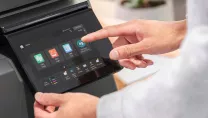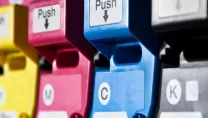2022 marks an impressive milestone for Sharp, as we’re celebrating an incredible 50 years of producing copiers. We introduced the Sharp SF-201 wet-toner copier way back in 1972, and we’ve been constantly innovating in the printer space ever since. Joe Tomota, Vice President at Sharp Europe, looks back at 50 years of copier innovation.
While most copiers on the market in 1972 employed diazo technology, where copies are initially made on special photosensitive papers, Sharp’s very first copier used the Electrofax (EF) method, where paper is given a static electric charge before being exposed to light reflected from the original document.
The EF method employed by the SF-201 provided outstanding results without worrying about ammonia odour, discoloration, or colour mixing. The SF-201 was so good, in fact, that Sharp produced another 10 series models in the four years following its launch, highlighting the strong commercial value of Sharp’s first copier.
Innovation is in the very DNA of Sharp, so it was no surprise that just two years after the SF-201, in 1974, we produced an industry first with the Sharp SF-710, which was the first plain paper copier to feature IC control in place of complex control mechanisms. Sharp was on a roll, and the innovation in the mid-70s continued with the SF-730 in 1976 - the industry's first copier to feature a pressure-fixing method for mono-component development toner.
Moving into1978, Sharp introduced the SF-810, which was the industry’s first stationary-platen desktop copier (PPC), and this was followed in 1979 by the Sharp SF-740, the world’s first copier to adopt a sheet metal optical unit, along with being the first best-selling machine to enable copying onto postcards.
Innovating Throughout the 1980s and 90s
The 1980s may have been a new decade, but Sharp continued where it left off, launching the Sharp SF-750 in 1981. It was a particularly popular machine, as the smallest and lightest copier to win a leading share in the United States, it was also the first model to utilise an OPC (Organic Photoconductor) sheet.
The trend for minimisation continued in 1984, when Sharp launched the Z-60, the world’s smallest B4 copier to use cartridge-type consumables. Two years later, in 1986, the Sharp SF-8200 was the first copier from Sharp to feature an OPC drum, picking up awards throughout the year.
In 1989, Sharp upped its game in the world of colour copying, launching the CX-7500, the company’s first full-colour analogue copier to achieve high-quality colour copying. It was a busy year for Sharp, as 1989 also saw the launch of the SF-8300, the first copier to feature automatic rotating drawers to save space.
Sharp kicked off the1990s in style, introducing the SD-2075 in 1991, which featured Sharp's unique advanced mechanism RDH (recirculating document handler) and the company’s first air-feeding mechanism.
Sharp launched the AR-5040 in 1994, and it was the company’s first digital copier with an electronic sort function. Sharp continued to add functionality to its copiers as the decade progressed, with the AR-5030F Sharp’s first digital copier to offer a fax function in 1995.
In 1996, the AR-5132 was the first digital MFP from Sharp to feature a network printing function, while the AR-C150 introduced digital colour functionality to Sharp’s MFP range in 1999, thanks to a colour tandem engine.
Moving Into a New Millennium
In 2007, Sharp launched the MX-4500DS, which proved the ideal MFP for convenience stores. This colour copier supported glossy A4-sized paper and L-sized photo printing and was the first copier to offer a calendar making function.
It was followed a year later by the award-winning A3 colour MFP MX-2600N, which won a BLI Pick of the Year award thanks to its outstanding image reproduction quality. It wasn’t the only Sharp copier to pick up an award that year, with Sharp’s first A4 colour MFP, the MX-C381, also winning BLI Pick of the Year.
Innovation remained high on the agenda, with the concept of making high-end digital functions easier to use with the introduction of the 10.1-inch LCD touchscreen on Sharp MFPs. The largest touchscreen of its kind at the time, allowed users to make smartphone-like gestures to easily carry out operations, such as print previews and changing document page order.
Over the next decade, Sharp continued to shape the copier landscape, and 2013’s MX-7500N was the company’s first flagship colour MFP for light production environments. In the same year, Sharp launched the MX-C300W, providing high-performance features in one of the industry’s smallest packages.
In 2016, the award-winning MX-6070N was the first MFP to achieve HCD-PP Certification, and it was followed a couple of years later by the BP-20C25, another award-winning colour MFP with a compact body designed to fit anywhere. Heading into the close of the decade, 2020’s Sharp MX-3631DS was a new MFP designed for convenience stores, introducing the industry’s first seal print functionality.
Remarkably, after five decades and more than 30 ground-breaking designs, Sharp continues to release products that set the standard. 2022’s BP-70C45 is the latest colour MFP from Sharp to include document technologies cultivated over 50 years, and forms part of our latest generation A3 MFP range.
The brand new ‘Future Workplace A3 MFP Series’ extends our eco-system of smart office tools, helping businesses seamlessly adapt to meet the demands of hybrid working. With innovative new features, one thing is certain – no other range of copiers on the market boast a heritage quite like Sharp’s latest machines. We are confident that 50 years of experience will surely satisfy our customers.
If you would like to know more about the history of the Sharp family of MFPs and office print solutions, please check out the dedicated Sharp MFP History page.





